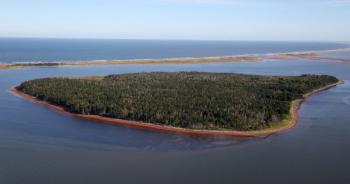Image Caption
Summary
Local Journalism Initiative Reporter
Windspeaker.com
On the northwestern corner of PEI is an island where great blue herons, double-crested cormorants, sandpipers, plovers and even bald eagles nest in undisturbed wetlands and Acadian forest.
Kwesawe’k (meaning end of the headland), also known as Oulton’s Island, has been privately owned until recently. The Nature Conservancy of Canada (NCC), with the help of anonymous donors, have negotiated the purchase of the 210-acre island for $1.2 million and are partnering with the Epekwitnewaq Mi’kmaq to protect this culturally and ecologically significant island. There is still $300,000 to be raised and NCC is asking people, businesses and foundations for their support.
Indigenous partnerships with NCC have happened before in Canada, but this is one of the first transfers of ownership in Atlantic Canada.
“Our people have always been guardians of the natural world, and we are pleased to continue that tradition while partnering with like-minded organizations such as NCC,” said Darlene Bernard, Lennox Island First Nation chief and Epekwitk Assembly of Councils co-chair.
“Collaboration on conservation with Indigenous people is both valuable and essential for all. The Mi’kmaq have occupied Epekwitk for over 12,000 years, and our deep cultural roots and relationship to the lands and waters are forever entrenched. We look forward to protecting and conserving this important part of Epekwitk together for generations to come.”
Mi’kmaq people living now remember going to the island as children, but part of the work will be to try to uncover where their ancestors have been present in the area thorough archaeological investigation. This would mean looking for evidence of pits of oyster and mussel shells to show where campsites were present and where people gathered.
The island is an important habitat for migrating waterfowl and small animals, like snowshoe hare and red squirrel.
Over the next few years, NCC and L’nuey, the initiative that focuses on the advancement, implementation, and protection of the constitutionally-entrenched rights of the Epekwitnewaq Mi’kmaq, will work together on the island. Full stewardship will be transferred to the Epekwitk Assembly of Councils in five years. This is the joint forum that oversees and governs organizations that act in the shared interest of Abegweit First Nation and Lennox Island First Nation. The Epekwitk Assembly of Councils will continue to conserve and care for Kwesawe’k in perpetuity.
“Here on Prince Edward Island we really like to protect coastal islands and that’s just because they’re often a haven for wildlife because they’re inaccessible to most humans,” said Lanna Campbell, NCC program director for PEI. “When you visit there, you feel like you’re intruding a bit because they have the run of the place. And so the nice thing about protecting these coastal islands is they remain havens for wildlife.”
“Our version of stewardship as a land trust is we get out and monitor the property annually, looking for things like marine debris that gathers on the shore. This is an island with four km of coastline. We also get out and take stock of wildlife,” Campbell said.
Kwesawe’k has been on NCC’s radar as an ecologically significant site since the ‘80s. When the island was previously on the market it was too expensive for purchase, but Campbell says there has been increased awareness in this corner of PEI recently of its cultural significance for the Mi’kmaq people.
“When we found out that there was a heightened interest in recognizing this area in that aspect and we had piqued the interest of a couple donors, the stars just started to align and we thought we may be able to get the island this time. And if we do it, we should give it back to the Mi’kmaq. We should return it to them because it’s not ours to begin with,” Campbell said.
The two groups have worked together on projects in caring for the nearby conservation areas on the Cascumpec and Conway Sandhills since 2009, so the discussion about Kwesawe’k began on an established base of trust and respect. Campbell said it’s been “truly collaborative from the beginning.”
“One of the things that is great about bringing land into conservation is we are removing a threat. When we bring land into conservation we are protecting it forever, so we are removing the threat of anything destructive ever happening to it.
To learn more about this project, get involved and donate, visit natureconservancy.ca/oultonsisland.

